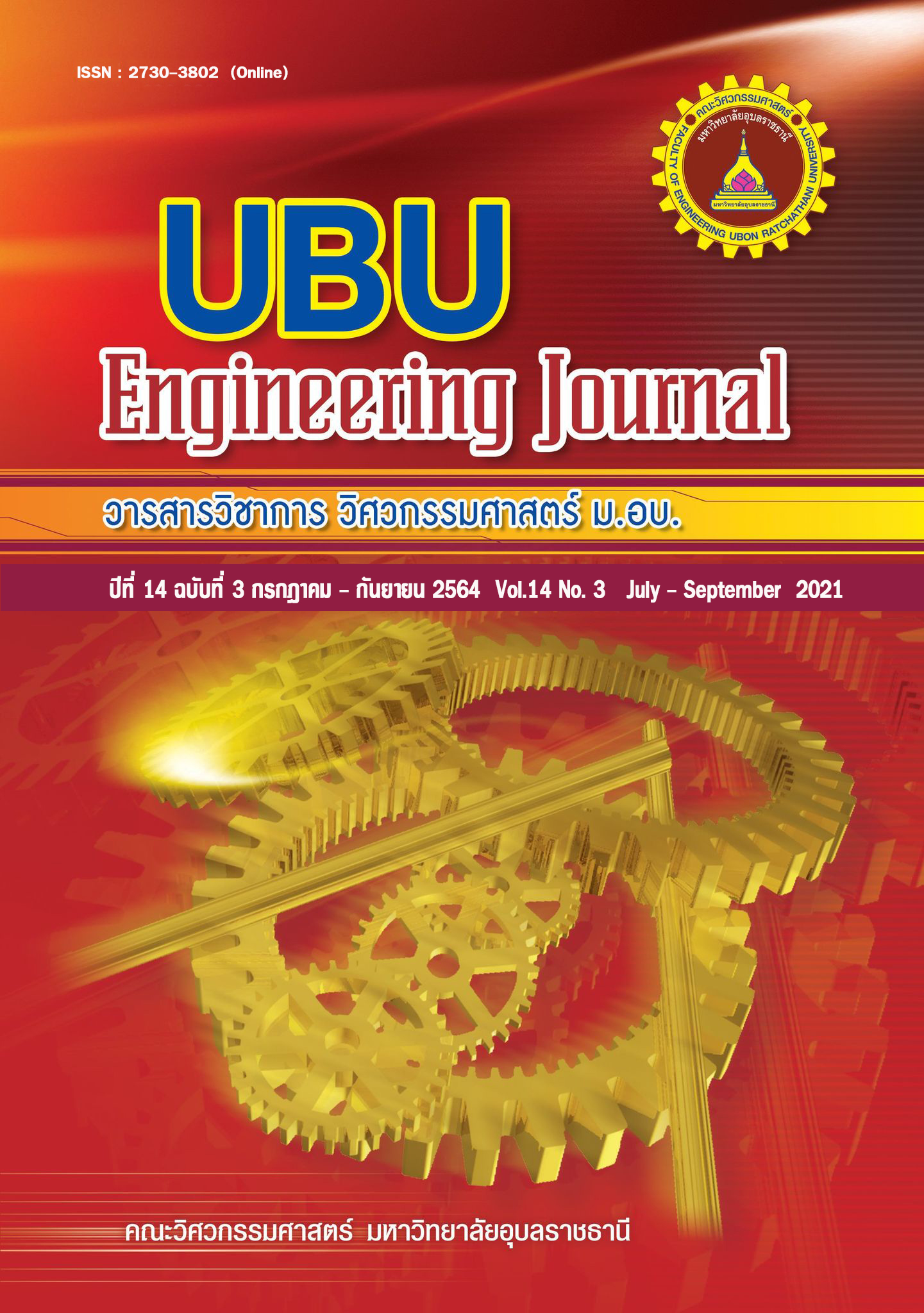Assessment of drought severity in the upper phong river basin
Main Article Content
Abstract
The assessment of drought severity in the upper phong river basin under future climate change impacts was based on the applications of SWAT and WEAP models. For future climate change during 2020 – 2099, the global climate models, i.e. CNRM - CM5, IPSL - CM5A – MR, and MIROC5, were used to project future climate under RCPs 4.5 and 8.5. The SWAT was calibrated and validated using R2 and Nash-Sutcliffe Efficiency (NSE) by comparing simulated with observed daily inflow to Ubol Ratana Reservoir during 2012 – 2017 and 2007 – 2011, respectively. The results indicated the R2 values of 0.76 and 0.70 and NSE values of 0.82 and 0.69 during calibration and validation, respectively, which give confidence on the result reliability. Considering the future climate prediction for 2020 – 2099, it was found that the maximum and minimum temperatures, and the mean annual rainfall, under RCPs 4.5 and 8.5 tend to be higher than the present, in which the mean annual rainfall under RCP 8.5 seems to be higher than RCP 4.5. Regarding the WEAP simulation results, during 2000 – 2017, it was found that Non Mueang Subdistrict Municipality and Din Dam Subdistrict are the areas with highest water demand, whereas the subdistricts of Din Dam, Nong Kae, and Nong Saeng are the areas with highest water scarcity. In addition, under both RCPs 4.5 and 8.5, the future water demand and water scarcity for agriculture tend to be decreasing, whereas for domestic, industry, and ecology, seem to be increasing. Thereafter, the assessment of drought severity was carried out based on Drought Hazard Index (DHI) which was calculated from Standardised Precipitation-Evapotranspiration Index (SPEI) and Water Scarcity Index (WSI), and the severity was categorized as normal, moderate, high, and very high. As a result, during 2000 – 2017, the years 2005, 2007, 2008, 2010, 2012, 2013, 2015, and 2016 are the periods with drought severity fluctuating between high and very high levels. The future climate change was also found to induce severe drought. As can be seen that under RCP 4.5 during 2020 – 2039 and 2040 – 2059, the area of 2,697.53 km2 is expected to fall in high level, whereas 688.86 km2 is anticipated in a very high level. In years 2060 – 2079 and 2080 – 2099, the area of 3,386.39 km2 might fall in a very high level. Under RCP 8.5, a high level is likely to occupied 3,386.39 km2 during 2020 – 2039 and 2040 – 2059, whereas a very high level is predicted throughout 3,386.39 km2 during 2060 – 2079 and 2080 – 2099. In conclusion, the main findings will be the information for analyzing and predicting drought severity levels. The action measures, preparedness, and coping strategies to mitigate future drought impacts, which might affect the residents in the upper phong river basin, can be determined, and the findings can also be used as a guideline for other river basins experiencing drought.
Article Details
References
[2] สำนักงานทรัพยากรน้ำแห่งชาติ. แผนแม่บทการบริหารจัดการทรัพยากรน้ำ 20 ปี (พ.ศ. 2561-2580). กรุงเทพฯ; 2561. หน้า 1-9.
[3] กรมอุตุนิยมวิทยา. การประเมินผลกระทบของสภาวะฝนที่มีต่อประเทศไทยโดยใช้ดัชนี GMI. กรุงเทพฯ; 2558. หน้า 1-8.
[4] Donald AW, Michael HG. Understanding: the drought phenomenon: The role of definitions. Water International 1985;10(3):111–120.
[5] สุจริต คูณธนกุลวงศ์, พงษ์ศักดิ์ สุทธินนท์, ปิยธิดา เรืองรัศมี, โชคชัย สุทธิธรรมจิต, วิชุตา เหมเสถียร. โครงการศึกษาผลกระทบจากการเปลี่ยนแปลงและความแปรปรวนของสภาพภูมิอากาศในอนาคต ความล่อแหลม เปราะบางและการปรับตัวของภาคส่วนที่สำคัญ. สหบรรณานุกรมห้องสมุดสถาบันอุดมศึกษาไทย. กรุงเทพฯ; 2560. หน้า 3-18.
[6] Neitsch SL, Arnold JG, Kiniry JR, Williams JR. Soil and Water Assessment Tool Theoretical Documentation Version 2009. Texas: Grassland, Soil and Water Research Laboratory, Agricultural Research Service and Blackland Research Center, Texas Agricultural Experiment Station, Temple, Texas. USA; 2011.
[7] บรรจงศักดิ์ ฟักสมบูรณ์ และนิพนธ์ ตั้งธรรม. การจำลองแบบพลวัตรเพื่อศึกษาการเปลี่ยนแปลงการใช้ประโยชน์ที่ดินที่ส่งผลต่อปริมาณน้ำท่าในลุ่มน้ำท่าจีนตอนบน. วารสารวิทยาศาสตร์บูรพา, 2560; 22(2): 42-57.
[8] กรมชลประทาน. คู่มือปฏิบัติงานเล่มที่ 8/16 การประเมินการใช้น้ำในกิจกรรมต่างๆ. กรุงเทพฯ; 2554. หน้า 5-7.
[9] Smakhtin V, Eriyagama N. Developing a software package for global desktop assessment of environmental flows. Environmental Modelling & Software 2008;23(12):1396-1406.
[10] Thomas B, McKee, Nolan J, Doesken, John Kleist. The relationship of drought frequency and duration to time scales. In: The Eighth Conference on Applied Climatology, American Meteorological Society, 17-22 Jan 1993, Anaheim, California. USA; 1993. p. 179-184.
[11] Michael J Hayes, Mark D Svoboda, Donald A Wiihite, Olga V Vanyarkho. Monitoring the 1996 Drought Using the Standardized Precipitation Index. Bulletin of the American Meteorological Society, BAMS 1999;80(3):429-438.
[12] Domínguez E, Moreno J, Ivanova Y. Water scarcity in a tropical country? - Revisiting the Colombian water resources. In: Global change: facing risks and threats to water resources: proceedings of the sixth World FRIEND conference, Fez, Morocco, October 2010. Morocco; 2010. p. 335-342.
[13] Falkenmark, M. The Massive Water Scarcity Now Threatening Africa: Why Isn't It Being Addressed?. A Journal of Environment and Society, AMBIO 1989;18(2):112-118.
[14] Damkjaer S, Taylor R. The measurement of water scarcity: Defining a meaningful Indicator. A Journal of Environment and Society, AMBIO 2017;46:513-53.
[15] ศูนย์ภูมิอากาศ. การเปลี่ยนแปลงอุณหภูมิและปริมาณฝนจากการคาดการณ์การเปลี่ยนแปลงภูมิอากาศในอนาคต. กรุงเทพฯ: กรมอุตุนิยมวิทยา; 2559. หน้า 13-30.
[16] Moriasi DN, Arnold JG, Van Liew MW, Bingner RL, Harmel RD, Veith TL. Model evaluation guidelines for systematic quantification of accuracy in watershed simulations. American Society of Agricultural and Biological Engineers, ASABE 2007;50(3):885-900.
[17] กรมป้องกันและบรรเทาสาธารณภัย. แผนป้องกันและบรรเทาสาธารณภัยแห่งชาติ. กรุงเทพฯ: 2559. หน้า 1-11.

